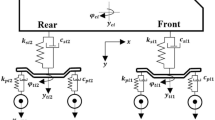Abstract
Based on the vehicle-track coupling dynamics theory, a new spatial dynamic numerical model of vehicle-track-subgrade coupling system was established considering the interaction among different structural layers in the subgrade system. The dynamic responses of the coupled system were analyzed when the speed of train was 350 km/h and the transition was filled with graded broken stones mixed with 5% cement. The results indicate that the setting form of bridge-approach embankment section has little effect on the dynamic responses, thus designers can choose it on account of the practical circumstances. Because the location about 5 m from the bridge abutment has the greatest deformation, the stiffness within 0–5 m zone behind the abutment should be specially designed. The results of the study from vehicle-track dynamics show that the maximum allowable track deflection angle should be 0.09% and the coefficient of subgrade reaction (K 30) is greater than 190 MPa within the 0–5 m zone behind the abutment and greater than 150 MPa in other zones.
Similar content being viewed by others
References
TB 10621-2009, High speed railway design specifications [S]. Beijing: China Railuay Publishing House, 2009.
NGUYEN D V, KIM K D, WARNITCHAI P. Simulation procedure for vehicle-substructure dynamic interactions and wheel movements using linearized wheel-rail interface [J]. Finite Elements in Analysis and Design, 2009, 45(5): 341–356.
XU Peng. Study on vibration of train-track-subgrade coupled system and running safety of train in earthquake [D]. Chengdu: Southwest Jiaotong University, 2012. (in Chinese)
ZHAI Wan-ming. The vertical model of vehicle-track system and its coupling dynamics [J]. Journal of Railway Engineering Society, 1992, 3(14): 10–21.
HANDOKO Y, DHANASEKAR M. An inertial reference frame method for the simulation of the effect of longitudinal force to the dynamics of railway wheelsets [J]. Nonlinear Dynamics, 2006, 45(3): 399–425.
AUCIELLO J, MELI E, FALORNI S, MALVEZZI M. Dynamic simulation of railway vehicles: Wheel-rail contact analysis [J]. International Journal of Advanced Robotic Systems, 2009, 47: 867–899.
PIOTROWSKI J, KIK W. A simplified model of wheel/rail contact mechanics for non-Hertzian problems and its application in rail vehicle dynamic simulations [J]. Vehicle System Dynamics, 2008, 46: 27–48.
SHACKLETON P, IWNICKI S. Comparison of wheel-rail contact codes for railway vehicle simulation — An introduction to the Manchester Contact Benchmark and initial results [J]. Vehicle System Dynamics, 2008, 46: 127–129.
VIL’KE V G, MAKSIMOV B A, POPOV S A. Stability of the rectilinear motion of a railway wheelset [J]. Moscow University Mechanics Bulletin, 2010, 65(2): 31–37.
AN M. Two simple fast integration methods for large-scale dynamic problems in engineering [J]. International Journal for Numerical Methods in Engineering, 1996, 39(24): 4199–4214.
STEENBERGEN M J M M, METRIKINE A V, ESVELD C. Assessment of design parameters of a slab track railway system from a dynamic viewpoint [J]. Journal of Sound and Vibration, 2007, 306(1/2): 361–371.
SUN Yan-quan. Use of Simulation in determination of railway track vertical dynamic forces in railway vehicle acceptance produce [C]// The Third International Conference on Mechanical Engineering and Mechanics, Fugang, Japan, 2009: 1052–1061.
GALVIN P, ROMERO A, DOMINGUEZ J. Vibrations induced by HST passage on ballest and non-ballast tracks [J]. Soil Dynamics and Earthquake Engineering, 2010, 30(9): 862–873.
LIAN Song-liang, LIU Yang, YANG Wen-zhong. Analysis of track irregularity spectrum of Shanghai-Nanjing railway [J]. Journal of Tongji University: Natural Science, 2007, 35: 1342–1346. (in Chinese)
DING Jun-jun, LI Fu. Numerical simulation of one side rail irregularity, Journal of Traffic and Transportion Engineering, 2010, 10: 29–35. (in Chinese)
WANG Kai-yun, ZHAI Wan-ming, CAI Cheng-biao. Comparison on track spectra of Qinghuangdao-Shenyang passenger railway line and German railway line [J]. Journal of Sounthwest Jiaotong University, 2007, 42: 425–430. (in Chinese)
QING Qi-xiang, WANG Yong-he, ZHAO Ming-hua. Research on dynamic performance of bridge (culvert)-subgrade transition section on Qin-shen High-speed railway [J]. Rock and Soil Mechanics, 2008, 29(9): 2415–2421.
MENG Fan-hui, HOU Yong-feng, WU Tao. Three-dimensional numerical analysis of bridge-approach embankment section [J]. Rock-Soil Mechanics, 2007, 28: 849–854. (in Chinese)
Author information
Authors and Affiliations
Corresponding author
Additional information
Foundation item: Project(41030742) supported by the National Natural Science Foundation of China; Project(2009G010-c) supported by the Technological Research and Development Programs of the Ministry of Railways, China
Rights and permissions
About this article
Cite this article
Yang, Cw., Sun, Hl., Zhang, Jj. et al. Dynamic responses of bridge-approach embankment transition section of high-speed rail. J. Cent. South Univ. 20, 2830–2839 (2013). https://doi.org/10.1007/s11771-013-1803-5
Received:
Accepted:
Published:
Issue Date:
DOI: https://doi.org/10.1007/s11771-013-1803-5




